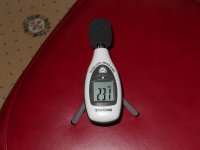I did some experiments with SPL measurements using ARTA running on my laptop. My audio setup is in our living room, which isn't exactly quiet. What was surprising is that I found our usual conversation to be only about 20-30dB above the ambient noise and my audio CD volume was about 30-40dB above the ambient noise. I tried stuffing the mic between a couple of pillows. Apparent ambient noise level stayed the same.I was wondering if there is a problem with the low quality mic I am using ($10 capacitive microphone for laptop). Perhaps my mic+laptop setup has just too high a level of noise.
The purpose of this experiment was to find out how accurate an amplifier we need. If the difference between ambient noise and peak listening level is only 40dB, we can't possibly need an accuracy of less than 0.1% THD+N (40dB SPL -> 30dB voltage -> 0.001 = 0.1% THD +N).
Would it be safe to conclude that spending more on a better amp would be useless without getting room acoustically sealed (at least reduce ambient noise)?
Comments very much appreciated.
The purpose of this experiment was to find out how accurate an amplifier we need. If the difference between ambient noise and peak listening level is only 40dB, we can't possibly need an accuracy of less than 0.1% THD+N (40dB SPL -> 30dB voltage -> 0.001 = 0.1% THD +N).
Would it be safe to conclude that spending more on a better amp would be useless without getting room acoustically sealed (at least reduce ambient noise)?
Comments very much appreciated.
It does not work like you described. First, a laptop microphone is not suitable for quantitative measurements. Second, an amplifier with less than 60 dB S/N would sound noisy, even in a noisy environment. This is because the amplifier noise is steady, but the environment noise is fluctuating pulses. Third, you don't need 0.1% THD for good sound.
Here are some figures from my experience: a quiet room has about 30dB SPL. An average loudspeaker produces 93 dB SPL for 1W input. An 50W amplifier will produce 110 dB SPL. The difference is 80 dB. So theoretically the THD+N should be >80dB, and it will sound "HiFi" if that is your goal.
As for the measuring technique, noise measurements are better done with a sound pressure level meter, in Leq (equivalent sound level) setting. Cheap SPL meters (and most software) indicate peaks only, which is misleading.
Here are some figures from my experience: a quiet room has about 30dB SPL. An average loudspeaker produces 93 dB SPL for 1W input. An 50W amplifier will produce 110 dB SPL. The difference is 80 dB. So theoretically the THD+N should be >80dB, and it will sound "HiFi" if that is your goal.
As for the measuring technique, noise measurements are better done with a sound pressure level meter, in Leq (equivalent sound level) setting. Cheap SPL meters (and most software) indicate peaks only, which is misleading.
Last edited:
It's hard to get a microphone and preamp quiet enough for good ambient noise measurements. It's also easy to hear things down into the noise, the same as you can understand a conversation in a noisy room at about the same level. As for amplifiers, this has been an ongoing debate near to forever. IMO, you can have good sound at near 1% THD (some old tube amps), but can have imperfect (I didn't want to say bad as it isn't) sound as low as 0.1% THD, maybe lower. Speaker efficiency and the type of THD will have a huge effect. Because we can build solid state amps with near zero distortion for very little money or effort today, why not do it and then worry about other things that are more important to good sound- better speakers, room treatments, good wine and maybe even music selection!
Thanks a lot everyone. I think I'll set a goal of 0.01% THD+N when building my own power amplifier. (Whether I achieve that is a different story, since it's my first attempt .)
Regardless of the THD+N figure, whether an amplifier sounds good is a subjective matter, so I'll not worry too much about that for now.
Regardless of the THD+N figure, whether an amplifier sounds good is a subjective matter, so I'll not worry too much about that for now.
- Status
- This old topic is closed. If you want to reopen this topic, contact a moderator using the "Report Post" button.
